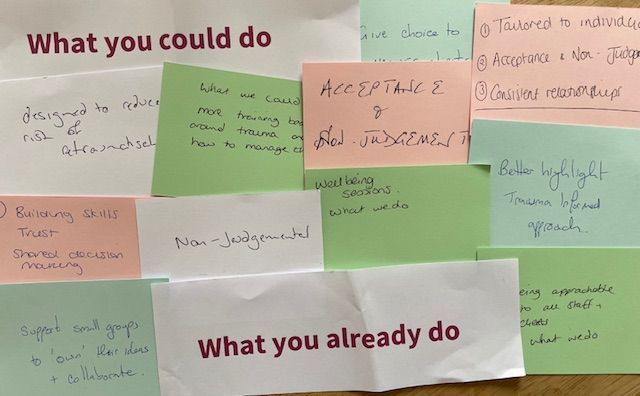How can volunteering improve health outcomes?
I was lucky to have an opportunity to discuss volunteering in healthcare settings, primarily hospitals, with NCVO, NHS England, NHS Trusts, a Healthwatch and Investing in Volunteers assessors. In the NHS’s Five Year Forward View , increasing community engagement including through volunteering is one the aims (see chapter 2). The purpose of the meeting was to look at how working towards and gaining Investing in Volunteers could help with this.
Organisations that have achieved the Investing in Volunteers quality award identify that it has had a positive impact on their volunteering programmes based on a previous impact report, but I wondered what the bigger picture was in terms of evidence about how volunteering helped to improve patients’ health outcomes.
So here are some of my thoughts after a quick review of the literature on the way home. I look at:
- The type of support the volunteers provide
- How these help healthcare services to achieve their outcomes
- How Investing in Volunteers can help with this process.
It’s not intended to be exhaustive, it’s a fairly short train journey back to Market Harborough, but I think provides a case:
- For the value that volunteers bring to patient satisfaction and health outcomes; and,
- That properly resourcing and managing the volunteer management programme makes a difference to these outcomes.
Investing in Volunteers 2021 - the updated standard
What sort of support do volunteers provide?
Faulkner and Davies (2004) break down volunteering support into four categories – the interpretations and comments are mine:
- Appraisal support that helps someone to think through the situation they are in, the impact on them, and how they might be able to deal with something, this could be counselling, but could be key worker / support worker roles.
- Informational support is, as it says, providing information to someone and can also include referral. This might include advice services in GP surgeries or social prescribing.
- Instrumental support is practical help, this could include support to help people to leave hospital and return home, such as safety checks, getting food in, settling someone back at home, or may involve providing goods, services or financial help.
- Emotional support that helps a person feel cared for, listened to, understood, this is typically provided by volunteers on wards, outpatients departments, clinics etc.
It is the power of volunteers to provide emotional support and why this is so important that I will focus on. The impact of social isolation on health is well documented. Hilary Cottam in a thought provoking TED Talk discusses how public services have become a series of transactions, but what is really transformation is the relationship between people – for example we know that the strength of the relationship between a therapist and a client is more important than the specific approach they take (De Haan, 2008).
Neuroscience helps with explanation: our brains are not optimally configured but have adapted over time and the different parts are not always working in harmony with each other. Networks of neurons carry messages from place to place in pathways that have been developed over years through repetition. Because the parts of the brain that are connected with keeping us safe, often provoking emotions that alert us, make predictions and operate at a faster speed than those that govern rational thought. Lewis et al point out, much of people’s brains are not “amenable to the pressure of argument and…much of one’s brain does not take orders” (2001: 33), instead identifying that changing how someone feels is a matter of tuning in to them at an emotional level, which has the ability to stablise and change their emotional state. It is this that clinical staff often don’t have time for, but volunteers do.
Handy and Srinivasan (2004) highlight the important role of volunteers in reducing patients’ anxiety, which they identify is important in quality of care. In addition, Hotchkiss et al cite research in America that “volunteers are more agreeable and extroverted than paid employees who performed the same jobs. This allows what otherwise might be an impersonal environment to become more personal and enhances patient satisfaction” which they theorise gives the organisation a “competitive advantage,” a notion that might be a bit strange (at least at the moment) to our NHS (2014: 1112).
In what ways can volunteers help healthcare services?
Hotchkiss et al (2014) identify a number of ways that volunteers can help hospitals or other services:
- Improving health outcomes through the activities above – researchers identify that more work needs to be done directly to link volunteering to health outcomes (e.g. Naylor et al in a Kings Fund report state, “There is a striking lack of information about the scale or impact of volunteering in health and social care. Addressing this should be a priority.”(2013, viii)). However, a picture is starting to emerge through some of the research cited in this article, and other initiatives such as social prescribing that are being developed (although these are not new, Faulkner (2004) evaluated a social prescribing type service in South Yorkshire in 2001-2).
- Increasing capacity and helping out staff Both Jones (2004) and Handy and Srinivasan (2004) surveyed staff in hospitals and found that they rated volunteers’ support highly in helping with their workloads. The latter found that providing personal care, providing support to patients and families in waiting rooms, clinics, support groups, and providing companionship and friendly visiting were most important for staff.
- Delivering early intervention and prevention activities either in the hospital or in the community, including peer support provided by volunteers who have had similar experiences.
- Providing positive messages about the health service to communities Jones (2004) identified that this can help to combat poor media coverage or poor general impressions, also suggesting that volunteers from diverse communities can help to increase social inclusion and community cohesion.
- Reducing people’s stay in hospital through hospital to home schemes, providing support for people to leave hospital who are currently there because of the need for social care / support rather than for medical reasons.
- Increasing donations to the hospital Handy and Srinivasan (2004) found that volunteers highly likely to donate to hospitals in fundraising campaigns as well as to be ambassadors into the general community.
Can Investing in Volunteers help to improve health outcomes?
Interested in Investing in Volunteers?
Bibliography
De Haan, E. (2008) Relational coaching. Chichester: John Wiley.
Faulkner, M., & Davies, S. (2005). “Social support in the healthcare setting: The role of volunteers” Health and Social Care in the Community , 13.
Handy, F., & Srinivasan, N. (2004) “Valuing volunteers: An economic evaluation of the net benefits of hospital volunteers” Nonprofit and Voluntary Sector Quarterly , 33
Hotchkiss, R., Unruh, L., and Fottler, M. (2014) “The Role, Measurement, and Impact of Volunteerism in Hospitals” in Nonprofit and Voluntary Sector Quarterly , 43(6)
Jones, H. (2004). Volunteering for health. Wales Council for Voluntary Action, Welsh Assembly Government. Available at www.wales.nhs.uk/documents/volunteering-for-health-report-e.pdf
Lewis, T., Amini, F. and Lannon, R (2001). A general theory of love. New York: Vintage Books.
Naylor, C., Mundle, C., Weaks, L., Buck, D. (2013) Volunteering in health and care Securing a sustainable future , The Kings Fund, available from http://www.kingsfund.org.uk/publications/volunteering-health-and-care
Rogers, S., Jiang, K., Rogers, R. and Intindola, M. (2016) “Strategic Human Resource Management of Volunteers and the Link to Hospital Patient Satisfaction” in Nonprofit and Voluntary Sector Quarterly 45(2)











